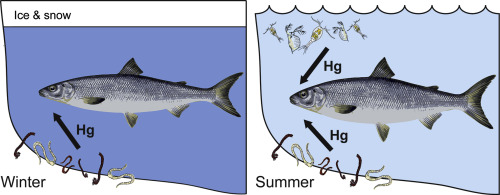Environmental Pollution ( IF 7.6 ) Pub Date : 2017-09-18 , DOI: 10.1016/j.envpol.2017.09.012 Ossi Keva , Brian Hayden , Chris Harrod , Kimmo K. Kahilainen

|
Subarctic lakes are characterised by extreme seasonal variation in light and temperature which influences growth, maturation, condition and resource use of fishes. However, our understanding of how seasonal changes affect mercury concentrations of fishes is limited. We conducted a year-round study (3 ice-covered months, 3 open-water months) with open-water inter-annual aspect (3 years: samples from August/September), focusing on total mercury (THg) concentrations and ecological characteristics of a common freshwater fish, European whitefish (Coregonus lavaretus (L.)) from a subarctic lake. We measured THg concentrations from tissues with fast (liver, n = 164) and moderate (muscle, n = 225) turnover rates, providing information on THg dynamics over different temporal scales. In both tissues, lipid-corrected THg concentrations were highest in winter (liver: 1.70 ± 0.88 μg/g, muscle: 0.24 ± 0.05 μg/g) and lowest in summer (liver: 0.87 ± 0.72 μg/g, muscle: 0.19 ± 0.04 μg/g). THg concentrations increased in winter following the summer-autumn dietary shift to pelagic zooplankton and starvation after spawning. Whitefish THg concentrations decreased towards summer, and were associated with consumption of benthic macroinvertebrates and subsequent growth dilution. Mercury bioaccumulated in both tissues with age, both showing the strongest regression slopes in winter and lowest in summer. THg concentrations in liver and muscle tissue were correlated throughout the year, however the correlation was lowest in summer, indicating high metabolism during somatic growing season in summer and growth dilution. Multiple linear regression models explained 50% and 55% of the THg variation in liver and muscle both models dominated by seasonally-variable factors i.e. sexual maturity, δ13C, and condition factor. Seasonally varying bioaccumulation slopes and the higher level of intra-annual variation (21%) in whitefish THg concentration in muscle than the inter-annual accumulation (8%) highlight the importance of including seasonal factors in future THg studies.
中文翻译:

北极湖中欧洲白鲑(Coregonus lavaretus(L.))的肝脏和肌肉中总汞浓度-评估驱动全年变化的因素
亚北极湖的特征是光和温度的极端季节性变化,这会影响鱼类的生长,成熟,状况和资源利用。但是,我们对季节性变化如何影响鱼类汞含量的理解是有限的。我们进行了全年研究(3个冰雪覆盖的月份,3个开放水月份),每年两次进行开放水域研究(3年:8月/ 9月的样本),重点研究了总汞(THg)浓度和生态特征普通淡水鱼,欧洲白鲑(Coregonus lavaretus)(L.))来自北极湖。我们以快速(肝脏,n = 164)和中度(肌肉,n = 225)周转率测量了组织中THg的浓度,从而提供了不同时间尺度上THg动态的信息。在这两个组织中,脂质校正的THg浓度在冬季最高(肝脏:1.70±0.88μg/ g,肌肉:0.24±0.05μg/ g),在夏季最低(肝脏:0.87±0.72μg/ g,肌肉:0.19± 0.04μg/ g)。夏季秋季饮食向中上浮游动物和产卵后饥饿后,THg浓度在冬季增加。白鱼THg浓度在夏季接近下降,并且与底栖大型无脊椎动物的食用和随后的生长稀释有关。汞随着年龄的增长而在两种组织中生物富集,在冬季均显示出最强的回归斜率,而在夏季均显示出最低的斜率。肝脏和肌肉组织中THg的浓度全年都相关,但是夏季的相关性最低,表明夏季体细胞生长季节的新陈代谢较高,且生长稀释。多个线性回归模型解释了肝脏和肌肉中THg的50%和55%的变化,这两个模型均受季节可变因素(即性成熟度,δ13 C和条件因子。季节性变化的生物蓄积斜率和肌肉中白鲑THg浓度的年内变化水平(21%)比年间积累水平(8%)更高,这突出了在以后的THg研究中纳入季节性因素的重要性。











































 京公网安备 11010802027423号
京公网安备 11010802027423号